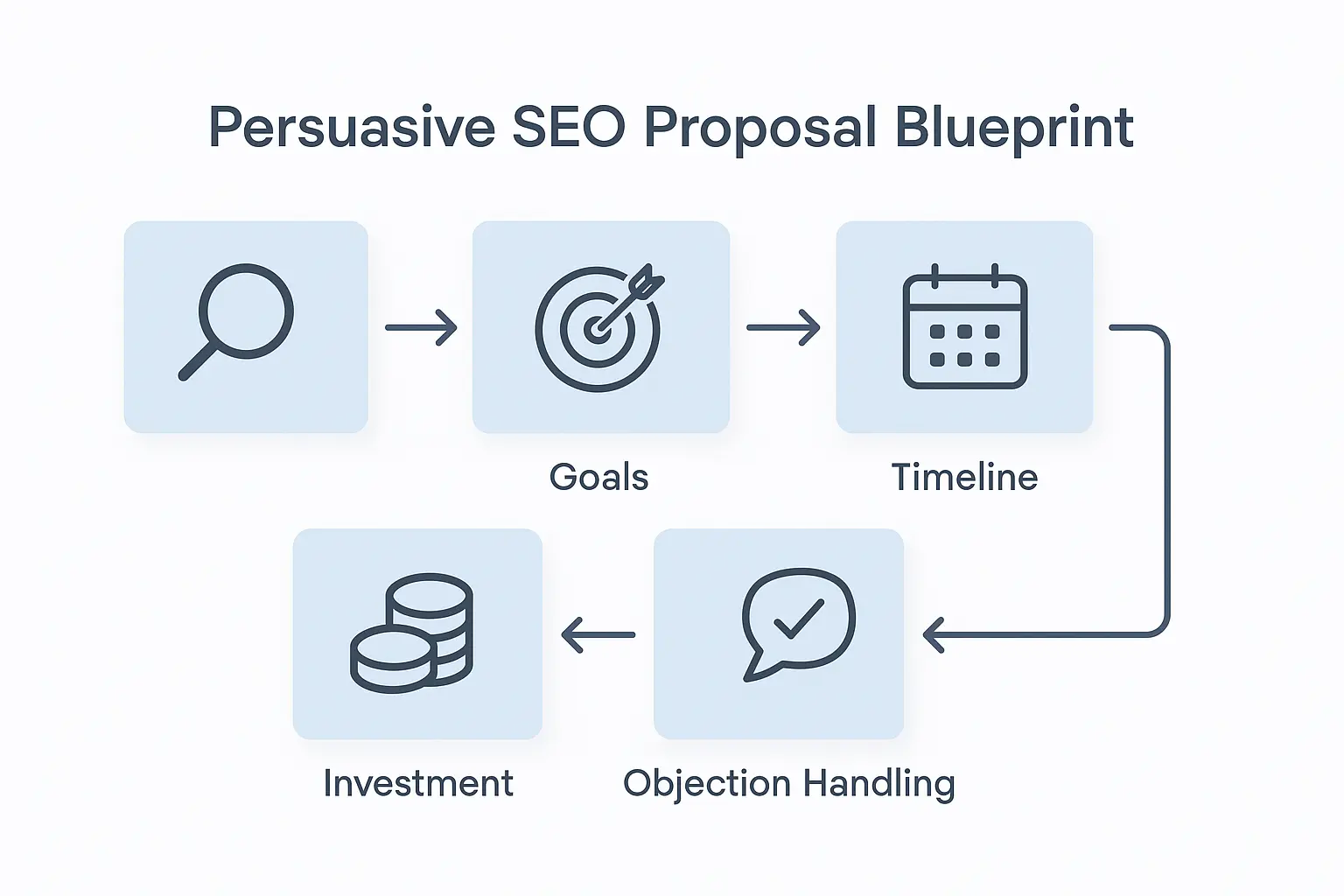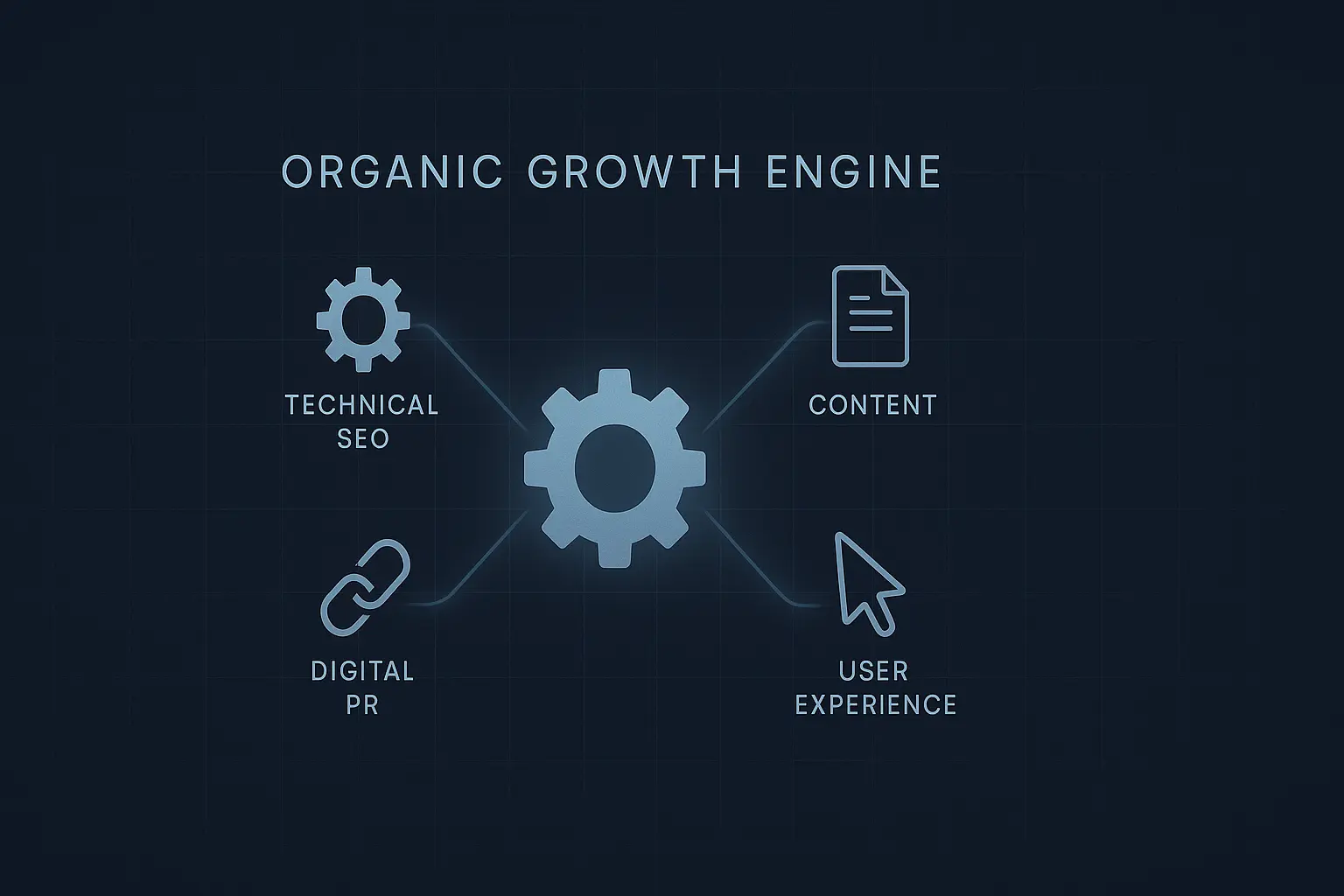You’ve had the meeting. The potential client is nodding along, they like your agency, and they agree they need to “do something” about their online presence. Then you send the proposal, and all that momentum hits a wall.
The client’s eyes scan for the price. They see “SEO Package: $X,XXX/mo” and immediately categorize it as a cost—a line item to be scrutinized, negotiated, or cut.
The problem isn’t your price. It’s your framing.
Most agencies sell SEO as a list of technical tasks: keyword research, on-page optimization, link building. But clients don’t buy tasks; they buy outcomes. They buy solutions to their biggest business problems—generating more leads, increasing sales, and building a brand that lasts.
This guide gives you the exact language and strategic frameworks to transform your SEO proposal from a list of costs into an undeniable investment in growth.
The Disconnect: Why Clients See SEO as a Cost, Not a Catalyst
Before we dive into the language, it’s crucial to understand the client’s perspective. They are constantly bombarded with marketing buzzwords. To them, “SEO” can sound like a vague, technical expense with a murky ROI.
The data, however, tells a different story. Your challenge is translating these powerful statistics into a compelling narrative for your client.
The Organic Opportunity: A staggering 53.3% of all website traffic comes from organic search. This isn’t just another channel; it’s the primary way customers discover, research, and connect with businesses online.
The Content Connection: Over 70% of marketers are actively investing in content marketing. Yet, many fail to connect that investment to a powerful distribution engine. Content without SEO is a billboard in the desert.
The Lead Generation Engine: For B2B clients, the case is even stronger: 61% of B2B marketers say SEO and organic traffic generate more leads than any other marketing initiative.
Your proposal’s job is to bridge the gap between their perception of SEO as a “cost” and the reality that it’s their most powerful engine for customer acquisition.
What Is “Integrated SEO”? (And Why It’s Easier to Sell)
First, redefine the product. Stop selling “SEO.” Start selling an “Organic Growth Engine” or “Integrated Digital Authority.” This isn’t just semantics; it’s a fundamental shift in value.
Integrated SEO isn’t a siloed activity. It’s a strategic approach that weaves together:
- Technical SEO: The foundational work that ensures search engines can crawl, understand, and trust your client’s website.
- Content Strategy: Creating valuable, relevant content that answers customer questions and establishes the client as an industry leader.
- Digital PR & Authority Building: Earning trust signals (like links and mentions) from other reputable sites to validate your client’s expertise.
- User Experience (UX): Ensuring the traffic you attract has a seamless journey that leads to a conversion.
When you frame it this way, you’re no longer selling a technical service. You’re selling a comprehensive system for attracting and converting high-intent customers. The complexity of modern SEO is a primary reason clients outsource it; they understand that a truly integrated approach requires deep, specialized expertise.

Crafting Your Proposal: From Line Items to Value Propositions
Let’s rebuild your proposal section by section, replacing technical jargon with value-driven language.
The “Current Situation” Snapshot
Don’t start with what you will do. Start with their pain. Use simple, clear language to articulate the problem you’re there to solve.
Instead of this:
“Your website has a low Domain Authority and is not optimized for target keywords.”
Try this (Value-Driven):
“Right now, your ideal customers are searching for solutions you provide, but they’re finding your competitors first. This means lost traffic, missed lead opportunities, and a weaker brand presence in a crowded market. Your website is a powerful asset, but it’s currently invisible to its most valuable audience.”
The Core Value Proposition: Your “Organic Growth Engine”
This is where you introduce your solution. Avoid a bulleted list of tasks. Instead, present a cohesive vision for their growth.
Instead of this:
“Our SEO package includes:
- Monthly keyword research
- On-page SEO
- Link building
- Technical audit”
Try this (Integrated Solution):
“We will build your Organic Growth Engine, a comprehensive system designed to establish your brand as the leading authority in your space. This isn’t about short-term tricks; it’s about creating a sustainable asset that generates qualified leads and sales month after month. Our approach has three core pillars:
-
Establish Technical Excellence: We’ll transform your website into a platform that search engines trust and reward, ensuring your content gets the visibility it deserves.
-
Become the Definitive Answer: We’ll uncover the most pressing questions your customers are asking and create content that makes your website the most valuable resource in your industry.
-
Build Unshakeable Authority: We’ll amplify your expertise across the web, earning trust signals that tell both Google and your customers that you are the go-to choice.”

Framing the Investment: Shifting from Cost to ROI
This is the most critical section. You need to anchor the price against the value it creates. Remind them of the alternative: the high cost of inaction.
Remember, research shows that content marketing delivers conversion rates 4.1x higher than other methods and generates three times more leads than paid search for every dollar spent. Use this to your advantage.
Instead of this:
“Price: $3,000/month”
Try this (Investment Framing):
“Your Investment in Sustainable Growth: $3,000/month
Think of this not as a marketing expense, but as an investment in an asset that grows in value over time. Unlike paid ads, which disappear the moment you stop paying, this program builds a foundation of organic traffic and authority that will pay dividends for years to come.
For less than the cost of a single junior hire, you gain an entire team of strategists, content experts, and technical specialists dedicated to making you the dominant voice in your market. Each month, this investment goes toward capturing high-intent customers who are actively searching for your solution.”
Handling Common Objections with Confidence
When you frame the proposal this way, many objections simply disappear. But for those that remain, here’s how to respond.
Objection 1: “Why is it an ongoing monthly fee? Can’t you just ‘SEO’ our site once?”
Your Response: “That’s a great question. Years ago, SEO could be treated as a one-time project. Today, the digital landscape is intensely competitive. Your competitors are constantly creating new content and earning authority, and search engines are constantly updating their standards. Our ongoing work ensures you not only gain ground but also defend and expand your position as the market leader. This is about building momentum, not just flipping a switch.”
Objection 2: “That sounds expensive. Can we get the same results with just PPC ads?”
Your Response: “PPC is an excellent tool for immediate, targeted traffic, and we often recommend it as part of a balanced strategy. But it’s like renting your audience—the traffic stops the moment you stop paying. Our Organic Growth Engine, on the other hand, is about building an asset. The content and authority we build are yours forever. In fact, studies show that SEO and content generate over three times more leads per dollar than paid search, making it the most cost-effective long-term growth strategy.”
Objection 3: “How long until we see results?”
Your Response: “You’ll see progress in leading indicators—like improvements in search rankings and organic traffic—within the first 90 days. But the real goal is building a sustainable pipeline of leads and sales, and that kind of foundational work typically takes six to nine months to fully mature. The results we achieve in month six are a direct result of the groundwork we lay in month one. This is a long-term growth play, not a short-term tactic.”
Whether you’re fulfilling this work with your own team or exploring scalable solutions like white-label SEO services, this confident, value-first framing is crucial for client buy-in.

Your Path Forward
Shifting your proposal language is the first step. The goal is to evolve your client conversations from simple transactions to strategic partnerships. When you educate clients on the why behind the what, you empower them to make smarter investments and position your agency as an indispensable part of their success.
By focusing on outcomes over activities, you don’t just sell more SEO packages—you build longer, more profitable client relationships. Positioning yourself as a strategic partner rather than a task-based vendor is the key to sustainable agency growth.
Frequently Asked Questions (FAQ)
What’s the difference between SEO and SEM?
Think of Search Engine Marketing (SEM) as the umbrella term for all search-related marketing. SEO (Search Engine Optimization) is the organic side—earning traffic through quality content and authority. PPC (Pay-Per-Click), like Google Ads, is the paid side—buying traffic. A strong strategy often uses both in tandem.
Why is content so important for SEO?
Search engines exist to provide users with the best possible answers to their questions. High-quality content—blog posts, guides, case studies—is how you provide those answers. Without valuable content, there’s nothing for Google to rank and no reason for customers to visit your site.
How do you measure the success of an SEO campaign?
We track success on multiple levels. In the short term, we look at leading indicators like keyword ranking improvements, organic traffic growth, and new backlinks. Ultimately, our success is measured by the business outcomes that matter most: increases in qualified leads, online sales, and customer inquiries from organic search.
Can’t we just use AI to write content for SEO?
AI is a powerful tool for brainstorming, outlining, and assisting in the content creation process. However, it can’t replace the deep industry expertise, strategic insight, and unique brand voice that builds true authority and trust with an audience. We use AI to make our experts more efficient, not to replace them.

